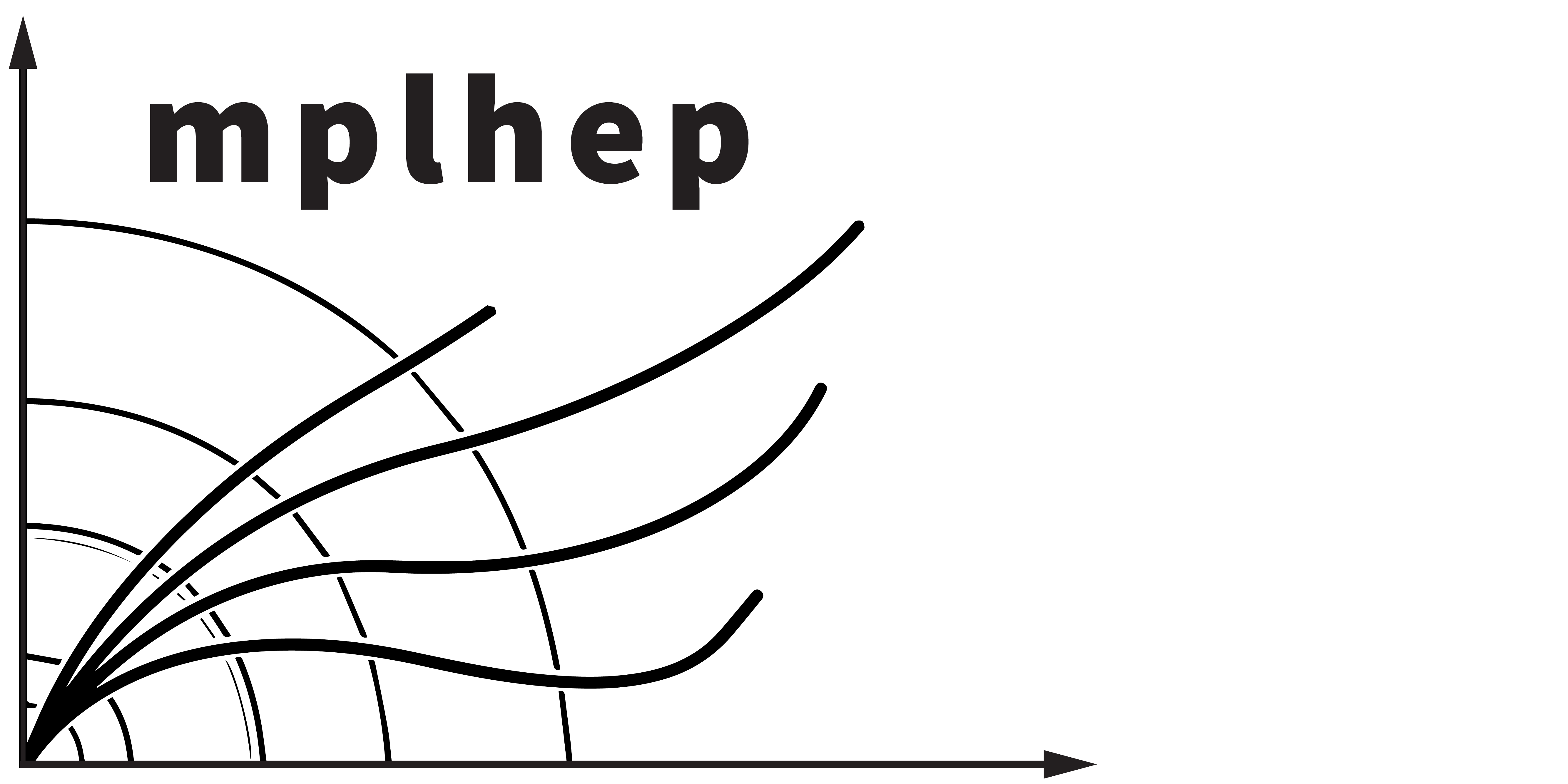A set of helpers for matplotlib to more easily produce plots typically
needed in HEP as well as style them in way that's compatible with current
collaboration requirements (ROOT-like plots for CMS, ATLAS, LHCb).
pip install mplhep
import matplotlib.pyplot as plt
import mplhep as hep
plt.style.use(hep.style.ROOT) # For now ROOT defaults to CMS
# Or choose one of the experiment styles
plt.style.use(hep.style.CMS)
# or
plt.style.use(hep.style.ATLAS)
# or
plt.style.use(hep.style.LHCb)
Experiment specific style are also available. If the default styles are not what you need, I'd be happy to merge in new styles or modify the current ones.
Default experiment labels are also available
# Overall - both left and right annotation
hep.<experiment>.label()
# Just experiment label and <text> such as 'Preliminary' or 'Simulation'
hep.<experiment>.text(<text>)
h, bins = [2, 3, 2], [0, 1, 2, 3]
hep.histplot(h, bins)
import numpy as np
xbins, ybins = [0, 1, 2, 3], [0, 1, 2, 3]
H = np.array([[2,3,2], [1,2,1], [3,1,3]])
hep.hist2dplot(H, xbins, ybins)
Several useful style adjustments differing form mpl defaults are also available separately or within
hep.mpl_magic()
- align axis labels to the right
- Set lower ylim to 0, if no data is obscured
- Autoscale upper ylim to fit legend without overlapping with plots
import numpy as np
import matplotlib.pyplot as plt
+ import mplhep as hep
x = np.random.uniform(0, 10, 240)
y = np.random.normal(512, 112, 240)
z = np.random.normal(0.5, 0.1, 240)
+ plt.style.use(hep.style.ROOT)
f, ax = plt.subplots()
ax.scatter(x,y, c=z);
A pre-binned histogram plotter is provided, as this functionality is currently
awkward in mpl.
import numpy as np
import matplotlib.pyplot as plt
+ import mplhep as hep
h, bins = np.histogram(np.random.normal(10,3,1000))
f, ax = plt.subplots()
- ax.step(bins, np.r_[h, h[-1]], step='post')
+ hep.histplot(h, bins)
Additional functionality is also wrapped inside.
- if
his a list of arrays or a 2d array, separate histograms will be plotted stack=Truestack plotsyerr={None | True | array of ndim = h.ndim | array of ndim = h.ndim + 1}is available to plot{ no | Poisson | one-sided | two-sided }errors.density=Trueshow densityweightshistype={'step' | 'fill'}edgeswhen plotting with'step'close the shape outside
An effort has been made to provide API as close as possible to plt.hist()
import numpy as np
import matplotlib.pyplot as plt
import mplhep as hep
fig, ax = plt.subplots()
xedges = [0, 1, 3, 5]
yedges = [0, 2, 3, 4, 6,7]
x = np.random.normal(2, 1, 100)
y = np.random.normal(4, 1, 100)
H, xedges, yedges = np.histogram2d(x, y, bins=(xedges, yedges))
hep.hist2dplot(H, xedges, yedges)
-
plt.style.use(style.ROOT)- Default (figure 10x10 inches, full column size) -
plt.style.use(style.ROOTlegacy)- Same as ROOT style above, but use ROOT fonts - Helvetica, fallback to Arial - instead of TeX Gyre Heros, requires font to be already available on the system -
plt.style.use(style.ROOTs)- Default (figure 6x6 inches, half column size) -
plt.style.use(style.fira)- use Fira Sans -
plt.style.use(style.firamath)- use Fira Math -
plt.style.use(style.ATLAS)- use default ATLAS style from https://github.com/kratsg/ATLASstylempl, note it defaults to Helvetica, which is not supplied in this package as explained below, and will only work properly if already available on the system
- e.g.
plt.style.use([style.ROOT, style.fira, style.firamath]) - reappearing rcParams get overwritten silently
- Since styles are dictionaries and they can be chained/overwritten they can be easiely modified on the fly. e.g.
plt.style.use(style.ROOT)
plt.style.use({"font.sans-serif":'Comic Sans MS'})
plt.style.use(style.ROOTtex)- Use LaTeX to produce all text labels- Requires having the full tex-live distro
- True Helvetica
- Use sansmath as the math font
- Takes longer and not always better
- In general more possibilities, but a bit more difficult to get everything working properly
+ plt.style.use(hep.cms.style.ROOT)
+ ax = hep.cms.cmslabel(data=False, paper=False, year='2017', ax=ax)As it is ROOT does not come with any fonts and therefore relies on using system fonts. Therfore the font in a figure can be dependent on whether it was produced on OSX or PC. The default sans-serif font used is Helvetica, but it only comes with OSX, in Windows this will silently fallback to Arial.
Both Helvetica and Arial are proprietary, which as far as fonts go means you can use it to create any text/graphics once you have the license, but you cannot redistribute the font files as part of other software. That means we cannot just package Helvetica with this to make sure everyone has the same font in plots.
Luckily for fonts it seems only the software is copyrighted, not the actual shapes, which means there are quite a few open alternatives with similar look. The most closely resembling Helvetica being Tex Gyre Heros
http://www.gust.org.pl/projects/e-foundry/tex-gyre/heros
You can compare yourself if the differences are meanigful below.
They are Tex Gyre Heros, Helvetica and Arial respecively.
- Math fonts are a separate set from regular fonts due to the amount of special characters
- It's not trivial to make sure you get a matching math font to your regular font
- Most math-fonts are serif fonts, but this is not ideal if one wants to use sans-serif font for normal text like Helvetica or Arial
- The number of sans-serif math-fonts is very limited
- The number of open sans-serif math-fonts is extremely limited
- Basically there's two, Fira Sans and GFS Neohellenic Math, of which I like Fira Sans better
- https://tex.stackexchange.com/questions/374250/are-there-opentype-sans-math-fonts-under-development
For consistent styling Fira Sans is included as well.
https://github.com/mozilla/Fira
https://github.com/firamath/firamath
with pyplot.style.context(style.ROOT):
plotting...
- This syntax would be ideal, however, it doesn't work properly for fonts and there are no plans by mpl devs to fix this behaviour matplotlib/matplotlib#11673
For now one has to set the style globally
plt.style.use(style.ROOT)
Updating list of citations and use cases of mplhep in publications:
- Simultaneous Jet Energy and Mass Calibrations with Neural Networks, ATLAS Collaboration, 2019
- Integration and Performance of New Technologies in the CMS Simulation, Kevin Pedro, 2020 (Fig 3,4)
- GeantV: Results from the prototype of concurrent vector particle transport simulation in HEP, Amadio et al, 2020 (Fig 25,26)
- Search for the standard model Higgs boson decaying to charm quarks, CMS Collaboration, 2019 (Fig 1)







